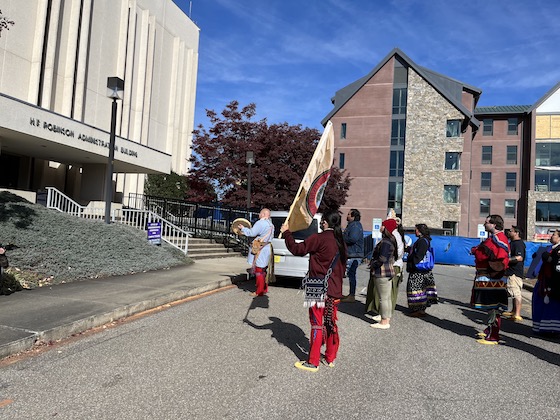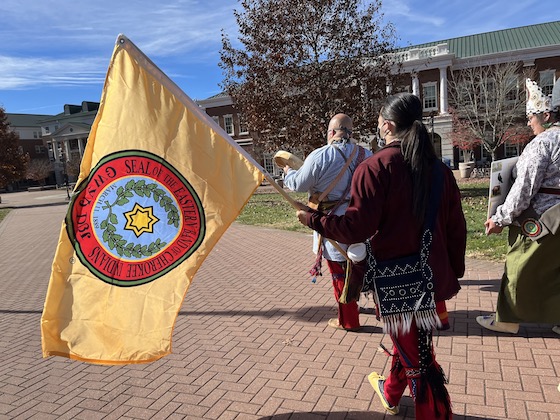The Eastern Band of Cherokee Indians have been on this land for much longer than Western Carolina University. This is something that the WCU Cherokee Center and Native American Student Organization wanted to make very clear on Nov. 15 as they marched around campus for the Rock Your Mocks walk.

“Rock Your Mocks is significant in remembrance and assertion; we remember the footpath of our ancestors and assert our footprint as Native people on this campus and in this country–our ancestral homeland,” said NASO president, Brooklyn Brown in an email.
Indigenous students, community members and allies joined together to walk the land that was once theirs, on National Rock Your Mocks day, which is celebrated annually by indigenous communities.
Many of the Indigenous people in attendance wore regalia such as ribbon skirts, beaded jewelry and of course, moccasins.
Sky Sampson, director of the WCU Cherokee Center, was dressed in a ribbon skirt made from fabric that contained letters from the Cherokee alphabet and ribbons that were WCU purple and gold. She also donned a sweatshirt containing the “wi” symbol, and had a red handprint painted on her face.
Sampson started the event by gathering everyone in a circle and read the informal WCU Land Acknowledgement. She then held a moment of silence for Murdered and Missing Indigenous Women, their families and the Every Child Matters movement.

The group started the walk by going to the H.F. Robinson Administration Building to get the attention of the staff by singing loud enough for them to hear. After, they walked back up campus to Noble Residence Hall, and ended at a statue of the Cherokee symbol, Wi, situated in the academic quad on campus. The sculpture indicates the center of what used to be a Cherokee village.
“I think the biggest thing we want to share is that we are still here,” said NASO public relations representative Sheyashe Littledave in a phone interview.
Sampson spoke about how many people thought the Cherokee and Indigenous groups as a whole are “a people of the past”. This walk is meant to bring awareness to the fact that they are very much present.
This is the first semester with the WCU Land Acknowledgement statement, giving recognition to the Indigenous land that WCU was built upon. This agreement has been a years long process before it was finally approved May 15, 2021.
“We always knew we were standing on our land here at WCU, but to know it is now written in the history of this university is refreshing for the decades of advocacy on this campus and in surrounding communities,” said Brown.

To get involved with NASO or the WCU Cherokee center, contact Brown at bdbrown7@catamount.wcu.edu.


